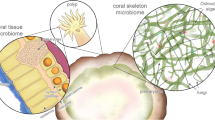Abstract
Boring microorganisms (microendoliths) are ubiquitous in living corals, constituting the skeleton microbiome important for coral health and reef resilience. Numerous microborings were recognized in Upper Jurassic (ca. 160 million years ago) corals (Pomerania, Poland) providing a glimpse into the oldest scleractinian skeleton microbiome so far. Scanning electron microscope study of resin casts of microborings (ca. 4 μm) revealed that they represent mostly the ichnospecies Ichnoreticulina elegans, commonly considered as traces of Ostreobium quekettii, an alga adapted for a low-light environment. The distribution pattern of microborings (occurrence in the inner part of the skeletal elements, commonly upward orientation) implies that they were not done post-mortem, but by microendoliths inhabiting the coral skeleton during coral life. These findings imply that the most common boring microorganism inhabiting the skeleton of Jurassic corals was, like in modern corals, O. quekettii or a similar green alga. The microbiome of dead parts of modern living colonies revealed by analysis of microborings is an unexplored, but is a perspective topic for research by reef biologists.




Similar content being viewed by others
References
Bentis CJ, Kaufman L, Golubic S (2000) Endolithic fungi in reef-building corals (Order: Scleractinia) are common, cosmopolitan, and potentially pathogenic. Biol Bull 198:254–260
Elias RJ, Lee D-J (1993) Microborings and growth in Late Ordovician halysitids and other corals. J Paleontol 67:922–934
Fine M, Loya Y (2002) Endolithic algae—an alternative source of energy during coral bleaching. Proc Biol Sci 269:1205–1210
Fordyce AJ, Ainsworth TD, Leggat W (2021) Light capture, skeletal morphology, and the biomass of corals’ boring endoliths. mSphere 6:e00060-e121
Golubic S, Brent G, Le Campion T (1970) Scanning electron microscopy of endolithic algae and fungi using a multipurpose casting embedding technique. Lethaia 3:203–217
Golubic S, Friedmann I, Schneider J (1981) The lithobiontic ecological niche, with special reference to microorganisms. J Sediment Petrol 51:475–478
Gutner-Hoch E, Fine M (2011) Genotypic diversity and distribution of Ostreobium quekettii within scleractinian corals. Coral Reefs 30:643–650
Iha C, Dougan KE, Varela JA, Avila V, Jackson CJ, Bogaert KA, Chen Y, Judd LM, Wick R, Holt KE, Pasella MM, Ricci F, Repetti SI, Medina M, Marcelino VR, Chan CX, Verbruggen H (2021) Genomic adaptations to an endolithic lifestyle in the coral-associated alga Ostreobium. Curr Biol 31:1393–1402
Kołodziej B, Golubic S, Bucur II, Radtke G, Tribollet A (2012) Early Cretaceous record of microboring organisms in skeletons of growing corals. Lethaia 45:34–45
Kołodziej B, Idakieva V, Ivanov M, Salamon K (2016) New record of endolithic algae syn vivo associated with an Early Cretaceous coral. Carnets Geol 16:633–640
Le Campion-Alsumard T, Golubic S, Hutchings P (1995) Microbial endoliths in the skeletons of live and dead corals: Porites lobata (Moorea, French Polynesia). Mar Ecol Prog Ser 117:149–157
Marcelino VR, Verbruggen H (2016) Multi-marker metabarcoding of coral skeletons reveals a rich microbiome and diverse evolutionary origins of endolithic algae. Sci Rep 6:31508
Pernice M, Raina JB, Rädecker N, Cárdenas A, Pogoreutz C, Voolstra CR (2020) Down to the bone: the role of overlooked endolithic microbiomes in reef coral health. ISME J 14:325–334
Radtke G (1991) Die mikroendolithischen Spurenfossilien im Alt-Tertiär West-Europas und ihre palökologische Bedeutung. Cour Forsch Senck 138:1–185
Radtke G, Golubic S (2005) Microborings in mollusk shells, Bay of Safaga, Egypt: morphometry and ichnology. Facies 51:118–134
Ricci F, Marcelino VR, Blackall LL, Kühl M, Medina M, Verbruggen H (2019) Beneath the surface: community assembly and functions of the coral skeleton microbiome. Microbiome 7:159
Ricci F, Fordyce A, Leggat W, Blackall LL, Ainsworth T, Verbruggen H (2021) Multiple techniques point to oxygenic phototrophs dominating the Isopora palifera skeletal microbiome. Coral Reefs 40:275–282
Rohwer F, Seguritan V, Azam F, Knowlton N (2002) Diversity and distribution of coral-associated bacteria. Mar Ecol Prog Ser 243:1–10
Roniewicz E (1984) Aragonitic Jurassic corals from erratic boulders on the south Baltic coast. Ann Soc Geol Pol 54:65–77
Salamon K, Kołodziej B (2021) Unravelling the microbiome of fossil corals: a message from microborings. Hist Biol. https://doi.org/10.1080/08912963.2021.1971213
Salamon K, Kołodziej B, Stefanskyi VL (2019) Simple methods for detection of microborings produced by coral-associated microendoliths. Facies 65:16
Salamon K, Kołodziej B, Löser H (2021) Diverse nature of ubiquitous microborings in Cenomanian corals (Saxonian Cretaceous Basin, Germany). Cretac Res 126:104888
Tribollet A (2008) The boring microflora in modern coral reef ecosystems: a review of its roles. In: Wisshak M, Tapanila L (eds) Current developments in bioerosion. Springer, Berlin, pp 67–94
van Oppen MJH, Blackall LL (2019) Coral microbiome dynamics, functions and design in a changing world. Nat Rev Microbiol 17:557–567
Vogel K, Brett CE (2009) Record of microendoliths in different facies of the Upper Ordovician in the Cincinnati Arch region USA: the early history of light-related microendolithic zonation. Palaeogeogr Palaeoclimatol Palaeoecol 281:1–24
Acknowledgements
We are grateful to Professor Ewa Roniewicz (Polish Academy of Sciences, Warszawa) for providing coral samples for investigation. The research is a contribution to K. Salamon’s project, funded by the National Science Centre, Poland (No. 2016/23/N/ST10/01334). B.K. and K.S. were additionally supported by Jagiellonian University. We are grateful to Dr. Lauren T. Toth and two anonymous referees for corrections and helpful comments on the manuscript.
Author information
Authors and Affiliations
Corresponding author
Ethics declarations
Conflict of interest
On behalf of all authors, the corresponding author states that there is no conflict of interest.
Additional information
Topic Editor Lauren T. Toth
Publisher's Note
Springer Nature remains neutral with regard to jurisdictional claims in published maps and institutional affiliations.
Rights and permissions
About this article
Cite this article
Salamon, K., Kołodziej, B., Radtke, G. et al. Microborings in Jurassic scleractinians: a glimpse into the ancient coral skeleton microbiome. Coral Reefs 41, 863–867 (2022). https://doi.org/10.1007/s00338-022-02248-5
Received:
Accepted:
Published:
Issue Date:
DOI: https://doi.org/10.1007/s00338-022-02248-5




